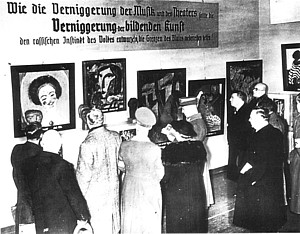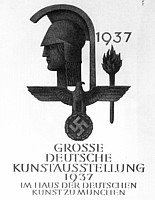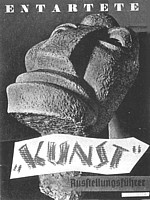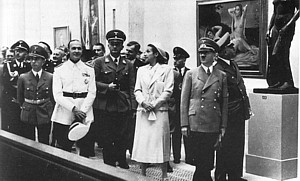The "Degenerate
Art" Exhibition (back to top)
The National Socialist rhetoric did not spring
from a vacuum. The hateful tirades against Bolsheviks, Jews and other
"alien elements" were not an isolated aberration in an otherwise
uninterrupted cultural history of civility and humanity. Much of the sentiments
expressed by the National Socialists had a long history. These verbal
outbursts of hatred stood in a continuum, although an intensely fanatic
one, of long-held ideas, originating in the 19th century.
Cultural degeneration was a subject discussed
by a range of Kulturkritiker beginning in the late 19th
century. There was in particular the very popular pseudo-scientific treatise
by Max Nordau, titled "Degeneration," in which he railed against
all modern art and literature as cause for mental and moral decline.[34].
This book, first published in 1893, was of decisive influence on the National
Socialist rhetoric and was particularly adopted by Hitler in his book
"Mein Kampf," published in 1923, in which he singled out Dadaism
as "the degenerate excess of insane and depraved humans".[35]
The idea of the artist as one "with highly refined, wilting, sickly
nerves," was also commonplace among intellectuals such as the vanguard
critic Hermann Bahr, the author Thomas Mann, and the painters Franz Marc
and Emil Nolde. Nietzsche’s call for renewal in the arts preceded the
frighteningly xenophobic cacophony of Nordau and others.[36]
According to Peter Paret, the general anxiety
in Germany about the future of moral, physical and intellectual strength
fostered the myth about a culturally distinctive and racially pure Volk.
While many of the artists at the end of the 19th century
perceived the alien elements infiltrating German art as those of the French
avant-garde,[37] radical cultural
critics like Phillip Stauff blamed destructive influences on the purity
of German culture on the greed of Jews, such as the prominent art dealer
Paul Cassirer and the Impressionist artist Max Liebermann. [38]
While Langbehn’s blood-and-soil ideology encouraged artists to work from
their roots, to stay away from French decadence, and to become authentic
representatives of their Stamm, conservative factions among the
cultural elite pointed to "the Jew" as a "dangerous enemy
that had penetrated the citadel of German culture, which he could now
corrupt and destroy from within."[39]
Given this history of cultural xenophobia and
the popularity of the aforementioned books, it is very likely that the
vocabulary used by the National Socialists was a familiar one not only
among the intellectual elite, but the bourgeoisie as well. National Socialist
propaganda made sure that the discourse surrounding the notion of the
"unhealthy" in a people became a common concept among the general
populace as well and could then be easily directed at intellectuals, artists,
Jews, Communists and all opponents to the Reich’s philosophy. And, very
soon after the rise of Hitler, the hatred at all that was "other"
extended from a purge of the museums to the removal from society of all
"outsiders"; impurities removed from a perceived culturally
and racially pure Volk.
As mentioned earlier, the chaos that preceded
the Great German Art Exhibition can be contrasted with the swift assembly
of prohibited "degenerate" art from the German state museums.
On the same day that he received Hitler’s approval for the "degenerate"
art show, June 30, 1937, Goebbels signed a decree as president of the
Reich Chamber for the Visual Arts and sent it to 101 museums in Germany.
It was to give access to all museum holdings to Professor Ziegler and
his committee in order to examine and secure works of German "decadence"
from 1910 onward for a show to be held in conjunction with the Grosse
Deutsche Kunstausstellung. Within a period of less than two weeks, Ziegler’s
committee confiscated 5,238 works of art.[40] During their zealous sweep through the museums, the
newly appointed "art connoisseurs" confiscated works by international
"degenerate" artists such as Picasso, Mondrian and the French
Post-Impressionists, thus overextending the authority given to them by
Goebbels. Most of the works by non-German modernist artists were ultimately
not shown in the "Degenerate Art" exhibitions, but instead sold
to the highest bidder at the Fischer auction in Lucerne, Switzerland,
in June and August of 1939.
The way that the commission proceeded in securing
the works deemed ‘degenerate’ was simple. Lists had been compiled of all
the artists mentioned in avant-garde periodicals, such as Das Kunstblatt,
Die Aktion, Der Sturm. Any books written by liberal museum directors
were scrutinized for names. A comprehensive guide to identifying the avant-garde
was Carl Einstein’s richly illustrated volume Die Kunst im 20. Jahrhundert,
published in 1926. It became a quick source for the uninitiated "art
specialist" to locate defamed works. Most importantly, though not
emphasized in most accounts of these confiscation raids, but foregrounded
in Die ‘Kunststadt’ München, is Wolfgang Willrich.[41]
According to Paul Rave, who was at that time an assistant to Hanfstaengel
of the National Galerie in Berlin, the selection of works for the "Degenerate
Art" exhibition followed a list comprised by Willrich, a hateful
art critic and, like Hitler, a mediocre artist. His book Säuberung
des Kunsttempels, was published in the spring of 1937. The arrangement
of collages and the inclusion of propaganda slogans and excerpts from
Hitler’s speeches reproduced in Willrich’s book would become a blueprint
for the "Degenerate Art" exhibition itself. Unfortunately, although
photographic records of the installation had been made, no catalogue was
created for the first "Degenerate Art" exhibition – there simply
was not time.[42] Therefore, much
of our impression of the inventory is based on the catalogue produced
for the show in Berlin, which followed four months later.
The Munich show "Degenerate Art"
coincided with the "Great German Art Exhibition" of July 1937.
Physically, the two exhibitions were almost across the street from one
another, the official German art in the newly erected Haus der Deutschen
Kunst in the Prinzregenten Strasse, and the other in a building occupied
by the Institute of Archeology in the Hofgarten. Crammed into dark, dank
rooms that had to be emptied of a collection of dusty plaster casts, were
650 paintings, sculptures and prints by 112 artists. [43]
The art had been confiscated, transported from various cities in Germany,
and installed in less than two weeks. But it was not lack of time that
caused this haphazard assembly of such chaotic dimension! The pompous
show of "the good German art" in the Haus der Kunst had little
more than one month for the new jury to select and to rehang and reposition
the paintings and sculptures. Yet, where Hitler’s pride in his grandiose
vision was at stake in one show, the disarray of works carelessly nailed
to the wall in the other was to showcase his contempt. What contrast between
the pristine shining halls of marble flooded with light, where officious
comments would complement the echo of the clicking boots, and the shuffling
of feet and the stunned silence in the tight tunnels of the storage rooms
for plaster heads![44]
 Some
of the narrow rooms contained works in thematic groupings, others contained
random collections of all subject matter, medium and style. All works
were installed in such a way as to promote disregard of the accomplishments
by the masters of modern art. Many of the paintings had been taken out
of their frames, and were often partly covered up by Nazi propaganda slogans
or derogatory slanderous remarks about the intent of the artist. Graffiti-like
large-scale scribbles on the walls connoted the degeneracy and lunacy
of the artists. The purposely added acquisition price for the works and
the name of the museum director was to establish further proof of the
conspiracy of the artistic elite with "alien elements" such
as Jews and Bolsheviks. Some
of the narrow rooms contained works in thematic groupings, others contained
random collections of all subject matter, medium and style. All works
were installed in such a way as to promote disregard of the accomplishments
by the masters of modern art. Many of the paintings had been taken out
of their frames, and were often partly covered up by Nazi propaganda slogans
or derogatory slanderous remarks about the intent of the artist. Graffiti-like
large-scale scribbles on the walls connoted the degeneracy and lunacy
of the artists. The purposely added acquisition price for the works and
the name of the museum director was to establish further proof of the
conspiracy of the artistic elite with "alien elements" such
as Jews and Bolsheviks.
The originators of the "Degenerate Art"
show were probably expecting violent reactions from the viewers. It did
not happen, according to the few eyewitness accounts presently published,
and if there were some derogatory remarks, they were relatively discreet.[45] Did anyone dare to verbally challenge the "official
opinion"? It would be interesting to know whether many of the visitors
to the "Degenerate Art" show also visited the Haus der Kunst,
and how they incorporated emotionally and intellectually one into the
other. Being pushed and shoved through the narrow rooms surrounded by
the surreal visual spectacle of malicious slogans and fantastic forms
and colors would at least have created a sense of claustrophobia in visitors.
By contrast, how would a leisurely walk through the spacious halls of
the Haus der Kunst surrounded by the sterile familiar genres have affected
average viewers? There is an essay in Schuster’s "Kunststadt München"
by an art student who had visited both shows. His reaction to the "accepted"
art was boredom and embarrassment and a sense of wonder when he encountered
the artists that he only knew from art books at this home.[46]
The show of the "degenerate" art ran in Munich from July 17,
1937 to November 30, 1937 and had the highest number of attendance ever
of any modern art show – 2,009,899, an average of 20,000 people per day.
Over 3,000,000 visitors in total were counted after the long run in other
cities in the Reich, including Berlin, Leipzig, Düsseldorf, Weimar, Halle,
Vienna and Salzburg.[47] The touring
of the exhibition ended in April of 1941. In Munich alone it attracted
twice as many visitors as the official art show at the Haus der Kunst
in the summer of 1937.
As the "Degenerate Art" exhibition
traveled on to other cities, the content changed. This was only partially
due to the loot from the second raid on German state museums, between
August and October 1937, which further boosted the inventory of the "degenerate"
art. As items were removed or simply broke during the transport from one
town to the next – like the large sculpture "The Kneeling Woman"
by Lehmbruck – others replaced them. Interesting is the removal of Franz
Marc’s gigantic "Tower of Blue Horses" shortly after the opening
in Munich upon the insistence of veteran officers from WWI. Franz Marc
had been a highly decorated officer who died in that war. After its removal
from the "Degenerate Art" show, the painting was never seen
again. Emil Nolde’s religious paintings were particularly defaced by malicious
slogans. This is curious because he was one of the earliest members of
the National Socialist party and an open racial supremacist; but his style
fit the category of "degenerate art." A few artists are testimony
to the ongoing process of a developing National Socialist style and the
abandonment by artists of their aesthetic principles. The sculptor Georg
Kolbe was represented with his earlier work in the "Degenerate Art"
show. As he altered his style to conform to the Third Reich’s aesthetic
demands, his idealized men and women in heroic poses gained entrance into
the annual shows at the Haus der Kunst. Although there were only five
Jewish artists represented among the 101 artists, the defamation of Jews
as degenerate profiteers of Germany’s cultural decline was present throughout
the exhibition in banners across paintings and graffiti on the walls.
From the dark, crowded corridors of the Archeological
Institute in the Hofgarten very few works made it to the elegant Grand
Hotel National in Lucerne, Switzerland, where on June 30, 1939 the jewels
among Germany’s art theft were auctioned off. Only 125 international masterworks
confiscated by the Ziegler commission were put up for sale to private
purchasers and art dealers from all parts of the world. The disposal of
profitable works, previously owned by German museums and private collections,
proceeded in an orderly fashion in neutral Switzerland.[48] The fate of most other confiscated paintings is a story
of greed and hate, cold-blooded profiteering and many pathetic and passionate
attempts to save a family heirloom or to protect a cultural treasure.
If it were not for the fanatic tendency of minute record keeping by members
of the bureaucratic National Socialist machinery, the random disposal
of the confiscated objects could only be reconstructed through private
memoirs.
Following the two principal raids on German
museums and private collection, Franz Hofmann, the chairman of the confiscation
committee, declared in March 1938 that the museums were now "purified".
In May 1938 Goebbels created a new commission calling "for the disposal
of confiscated works of the degenerate art."[49]
Hitler visited the depot himself, and in June of that year decreed a law
that would free the government from all compensation claims for the "safeguarded"
works.[50] During the previous
fall, the works of art that were not "on tour" had been collected
in warehouses in the Köpenicker Strasse in Berlin. Surviving records indicate
that there were a total of 12,890 inventoried paintings, sculptures, water
colors and prints. Of these an unknown number was subsequently taken to
Schloss Niederschönhausen outside of Berlin to be made available to international
buyers.[51] The number of works held at both depots decreased rapidly,
however, as dealers paid as little as $20.00 for a modern master or as
private citizens attempting to safeguard German modern art rushed to offer
Nazi approved art in exchange for art deemed "degenerate."[52] There was only a small window of opportunity to acquire
works collected in these two depots. In December 1938 Goebbels and Hans
Hoffmann, the photographer and unofficial artistic advisor of Hitler,
began a campaign to burn all works remaining in the Köpenicker Strasse
depot. By the time a secret bonfire was set to destroy that which was
deemed worthless, the number of objects had shrunk to 1,004 paintings
and sculptures and 3,825 drawings, water colors and graphics.[53]
Before these works went up in flames on March 20, 1939, they were, of
course, inventoried.
While very few of the objects displayed in
the "Degenerate Art" shows were sold through proper channels
– if we consider the auctions in Switzerland to be proper – all of the
sculptures and paintings exhibited in the annual Great German Art Exhibition
were offered and sold within the framework of an art market. After Hitler
had abandoned his lofty idea of a permanent collection of art for the
people and the state, the "temple of art" merely carried on
the tradition of the old Münchner Glaspalast, the exhibition and sale
of art for the general populace. It thus reflected and continued the standard
practice in provincial art centers. As Hinz observed in his book Art
in the Third Reich, "sales opportunities were excellent."[54] On the average, 800 to 1,000 objects
shown in the Haus der Kunst were sold each year. At that rate, it is doubtful
that the 884 pieces shown in the inaugural exhibition remained in the
"temple" for very long. A large proportion of the paintings
and sculptures were purchased for public buildings, government offices
and private homes for government officials, according to Hinz. I conclude
from this, that most of the 700 objects labeled National Socialist art,
that are now deposited in the "Depot for Art between 1930 and 1945"
in Berlin were secured from such public and official buildings by the
Allied powers after the war. This is a small number of all the works created
for the Reich, and, aside from the likelihood that a large amount was
destroyed during the war, there must still be many objects in circulation
that carry the face of the National Socialist ideology. A blockbuster
show, titled "One Century of Art in Germany," took place in
Berlin in September 1999. One room of the show was dedicated to Germany
in the Third Reich. A Volkswagen car shared the space with Adolf Ziegler’s
banal nudes and Arno Breker’s monumental, soulless "Prometheus".
|



